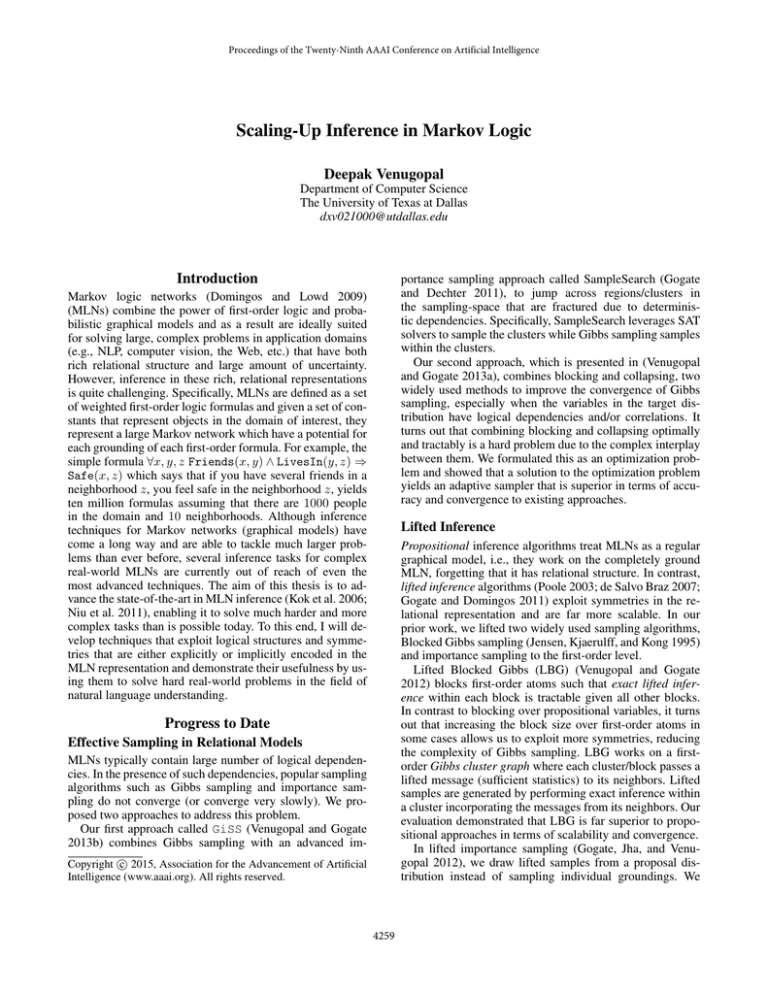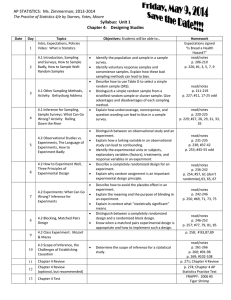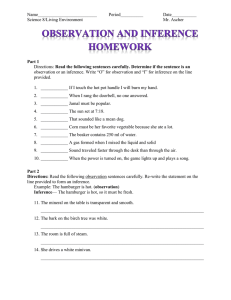
Proceedings of the Twenty-Ninth AAAI Conference on Artificial Intelligence
Scaling-Up Inference in Markov Logic
Deepak Venugopal
Department of Computer Science
The University of Texas at Dallas
dxv021000@utdallas.edu
Introduction
portance sampling approach called SampleSearch (Gogate
and Dechter 2011), to jump across regions/clusters in
the sampling-space that are fractured due to deterministic dependencies. Specifically, SampleSearch leverages SAT
solvers to sample the clusters while Gibbs sampling samples
within the clusters.
Our second approach, which is presented in (Venugopal
and Gogate 2013a), combines blocking and collapsing, two
widely used methods to improve the convergence of Gibbs
sampling, especially when the variables in the target distribution have logical dependencies and/or correlations. It
turns out that combining blocking and collapsing optimally
and tractably is a hard problem due to the complex interplay
between them. We formulated this as an optimization problem and showed that a solution to the optimization problem
yields an adaptive sampler that is superior in terms of accuracy and convergence to existing approaches.
Markov logic networks (Domingos and Lowd 2009)
(MLNs) combine the power of first-order logic and probabilistic graphical models and as a result are ideally suited
for solving large, complex problems in application domains
(e.g., NLP, computer vision, the Web, etc.) that have both
rich relational structure and large amount of uncertainty.
However, inference in these rich, relational representations
is quite challenging. Specifically, MLNs are defined as a set
of weighted first-order logic formulas and given a set of constants that represent objects in the domain of interest, they
represent a large Markov network which have a potential for
each grounding of each first-order formula. For example, the
simple formula ∀x, y, z Friends(x, y) ∧ LivesIn(y, z) ⇒
Safe(x, z) which says that if you have several friends in a
neighborhood z, you feel safe in the neighborhood z, yields
ten million formulas assuming that there are 1000 people
in the domain and 10 neighborhoods. Although inference
techniques for Markov networks (graphical models) have
come a long way and are able to tackle much larger problems than ever before, several inference tasks for complex
real-world MLNs are currently out of reach of even the
most advanced techniques. The aim of this thesis is to advance the state-of-the-art in MLN inference (Kok et al. 2006;
Niu et al. 2011), enabling it to solve much harder and more
complex tasks than is possible today. To this end, I will develop techniques that exploit logical structures and symmetries that are either explicitly or implicitly encoded in the
MLN representation and demonstrate their usefulness by using them to solve hard real-world problems in the field of
natural language understanding.
Lifted Inference
Propositional inference algorithms treat MLNs as a regular
graphical model, i.e., they work on the completely ground
MLN, forgetting that it has relational structure. In contrast,
lifted inference algorithms (Poole 2003; de Salvo Braz 2007;
Gogate and Domingos 2011) exploit symmetries in the relational representation and are far more scalable. In our
prior work, we lifted two widely used sampling algorithms,
Blocked Gibbs sampling (Jensen, Kjaerulff, and Kong 1995)
and importance sampling to the first-order level.
Lifted Blocked Gibbs (LBG) (Venugopal and Gogate
2012) blocks first-order atoms such that exact lifted inference within each block is tractable given all other blocks.
In contrast to blocking over propositional variables, it turns
out that increasing the block size over first-order atoms in
some cases allows us to exploit more symmetries, reducing
the complexity of Gibbs sampling. LBG works on a firstorder Gibbs cluster graph where each cluster/block passes a
lifted message (sufficient statistics) to its neighbors. Lifted
samples are generated by performing exact inference within
a cluster incorporating the messages from its neighbors. Our
evaluation demonstrated that LBG is far superior to propositional approaches in terms of scalability and convergence.
In lifted importance sampling (Gogate, Jha, and Venugopal 2012), we draw lifted samples from a proposal distribution instead of sampling individual groundings. We
Progress to Date
Effective Sampling in Relational Models
MLNs typically contain large number of logical dependencies. In the presence of such dependencies, popular sampling
algorithms such as Gibbs sampling and importance sampling do not converge (or converge very slowly). We proposed two approaches to address this problem.
Our first approach called GiSS (Venugopal and Gogate
2013b) combines Gibbs sampling with an advanced imc 2015, Association for the Advancement of Artificial
Copyright Intelligence (www.aaai.org). All rights reserved.
4259
in several MLN inference and learning algorithms. Specifically, variants of #SATGround manifest themselves in
algorithms such as Gibbs sampling, MaxWalkSAT, voted
perceptron, contrastive divergence and pseudo-likelihood
learning. Existing MLN inference/learning systems (Kok
et al. 2006; Niu et al. 2011) naively solve #SATGround
greatly diminishing their scalability. We want to connect
#SATGround to solution counting in graphical models and
leverage decades of advances in space/time efficient counting strategies to develop a family of scalable MLN inference/learning algorithms.
showed that sampling from such a lifted space reduces the
variance of estimates derived from the samples and developed a scalable method for constructing the proposal that
applies several lifted inference rules approximately.
Improving Scalability through Approximate
Symmetries
A key problem with lifted inference methods is that they
tend to work well only when the MLN has specific symmetric structure, which is often not the case in real-world applications. Moreover, evidence breaks symmetries, further diminishing their performance. As a result, in practice, for arbitrary MLN/evidence structures, lifted inference is as scalable as propositional inference.
In our recent ECML paper (Venugopal and Gogate
2014b), we proposed a general, practical approach to scaleup inference in MLNs without any restrictions on its structure or evidence. We utilized standard unsupervised machine
learning approaches such as KMeans to cluster objects based
on approximate symmetries and generated a “compressed”
MLN in which the objects are replaced by their clustercenters. To learn these approximate symmetries, we developed a distance measure between two distinct objects in a
domain based on the evidence presented to the MLNs.
In a related paper (Venugopal and Gogate 2014a), we
showed how to scale-up importance sampling for arbitrary
MLN/evidence structures and at the same time provided several approximation guarantees. Specifically, we used lifted
Gibbs sampling to tractably sample from an informed proposal that we constructed using the “compressed” MLN.
Further, we approximated the importance weight of each
sample tractably such that we obtain asymptotically unbiased estimates.
References
de Salvo Braz, R. 2007. Lifted First-Order Probabilistic Inference.
Ph.D. Dissertation, University of Illinois, Urbana-Champaign, IL.
Domingos, P., and Lowd, D. 2009. Markov Logic: An Interface
Layer for Artificial Intelligence. Morgan & Claypool.
Gogate, V., and Dechter, R. 2011. SampleSearch: Importance sampling in presence of determinism. Artificial Intelligence
175(2):694–729.
Gogate, V., and Domingos, P. 2011. Probabilistic Theorem Proving. In Proceedings of the 27th Conference on Uncertainty in Artificial Intelligence, 256–265. AUAI Press.
Gogate, V.; Jha, A.; and Venugopal, D. 2012. Advances in Lifted
Importance Sampling. In Proceedings of the 26th AAAI Conference
on Artificial Intelligence. AAAI Press.
Jensen, C. S.; Kjaerulff, U.; and Kong, A. 1995. Blocking Gibbs
Sampling in Very Large Probabilistic Expert Systems. Internat. J.
Human-Computer Studies 42:647–666.
Kok, S.; Sumner, M.; Richardson, M.; Singla, P.; Poon, H.; and
Domingos, P. 2006. The Alchemy System for Statistical Relational
AI. Technical report, University of Washington.
Niu, F.; Ré, C.; Doan, A.; and Shavlik, J. W. 2011. Tuffy: Scaling up Statistical Inference in Markov Logic Networks using an
RDBMS. PVLDB 4(6):373–384.
Poole, D. 2003. First-Order Probabilistic Inference. In Proceedings of the 19th International Joint Conference on Artificial Intelligence, 985–991.
Venugopal, D., and Gogate, V. 2012. On Lifting the Gibbs Sampling Algorithm. In Proceedings of the 26th Annual Conference on
Neural Information Processing Systems, 1664–1672.
Venugopal, D., and Gogate, V. 2013a. Dynamic Blocking and Collapsing for Gibbs Sampling. In Proceedings of the 29th Conference
on Uncertainty in Artificial Intelligence.
Venugopal, D., and Gogate, V. 2013b. GiSS: Combining Gibbs
Sampling and SampleSearch for Inference in Mixed Probabilistic
and Deterministic Graphical Models. In Proceedings of the 27th
AAAI Conference on Artificial Intelligence.
Venugopal, D., and Gogate, V. 2014a. Scaling-up Importance
Sampling for Markov Logic Networks. In Proceedings of the
28th Annual Conference on Neural Information Processing Systems (NIPS).
Venugopal, D., and Gogate, V. 2014b. Evidence-Based Clustering
for Scalable Inference in Markov Logic. In Machine Learning and
Knowledge Discovery in Databases - European Conference, ECML
PKDD.
Venugopal, D.; Chen, C.; Gogate, V.; and Ng, V. 2014. Relieving
the Computational Bottleneck: Joint Inference for Event Extraction
with High-Dimensional Features. In Empirical Methods on Natural Language Processing.
Application: Event Extraction
An effective approach to event extraction in NLP is joint
inference, namely, methods that reason about relational dependencies between events. In our recent paper (Venugopal
et al. 2014), we developed a joint inference based event extraction system using MLNs. However, it turns out that the
key linguistic features that are useful in event extraction are
extremely high dimensional and therefore learning them effectively using MLNs requires an infeasible amount of data.
SVMs on the other hand, lack the ability to perform joint inference but are very well-suited to handle high-dimensional
features. To get the best of both worlds, we learned high dimensional features using SVMs and encoded them as lowdimensional soft-evidence in MLNs. Further, by exploiting the MLN’s structural properties, we ensured the computational feasibility of joint inference. On three BioNLP
datasets, our system was better or on par with the best systems and outperformed all previous MLN-based systems.
Future Work
A counting problem which we call #SATGround (counting the satisfied groundings of a first-order formula given
assignments ground atoms) is arguably the main bottleneck
4260






